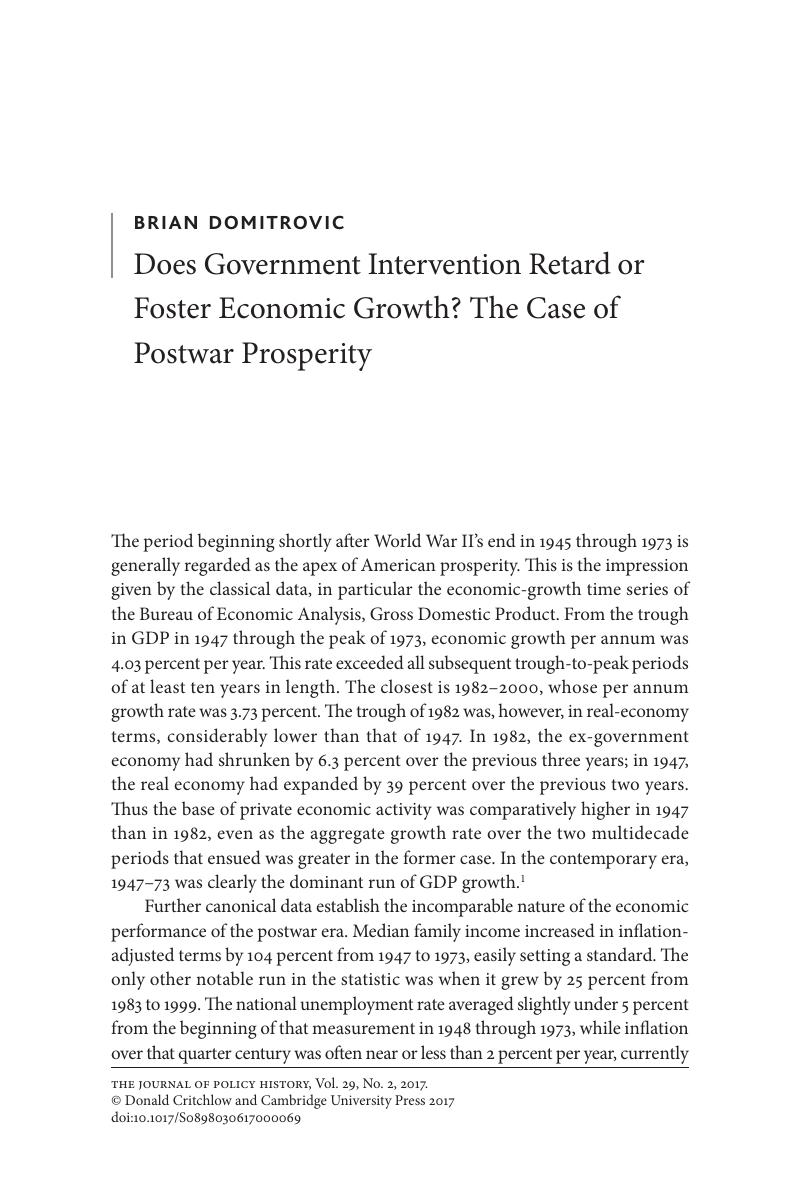Article contents
Does Government Intervention Retard or Foster Economic Growth? The Case of Postwar Prosperity
Published online by Cambridge University Press: 14 March 2017
Abstract

- Type
- Articles
- Information
- Journal of Policy History , Volume 29 , Special Issue 2: Is Political Liberty Necessary for Economic Freedom? , April 2017 , pp. 289 - 304
- Copyright
- Copyright © Donald Critchlow and Cambridge University Press 2017
References
NOTES
1. Growth calculations proceed according to National Income and Product Accounts guidelines, and aggregate government spending figures are taken from www.usgovernmentspending.com.
2. Median family income derives from various issues of the U.S. Census Bureau’s Current Population Survey, and the historical National Unemployment Rate is given by the Bureau of Labor Statistics, also the source of inflation data. For example, Jason Furman, “Broadband, Economic Growth, and the Implications for Spectrum Policy,” keynote address at the American Enterprise Institute, 17 September 2013, p. 2, http://www.aei.org/wp-content/uploads/2013/09/-jason-furman-remarks-broadband_115357553476.pdf.
3. Recession dating is care of “US Business Cycle Expansions and Contractions,” NBER.
4. Rockefeller Brothers Fund, The Challenge to America: Its Economic and Social Aspects (Garden City, N.Y., 1958)Google Scholar; “The Platform Statements by Rockefeller and Nixon,” New York Times, 24 July 1960; “Democratic Party Platform,” 11 July 1960, The American Presidency Project, http://www.presidency.ucsb.edu/.
5. In a considerable literature, see Collins, Robert M., More: The Politics of Economic Growth in Postwar America (New York, 2000).CrossRefGoogle Scholar
6. “Historical Tables,” Budget of the United States Government, Fiscal Year 2016. Nominal dollars are controlled via the BLS Consumer Price Index.
7. Wilbur D. Mills, Foreword, Tax Revision Compendium: Compendium of Papers on Broadening the Tax Base, vol. 1 (Washington, D.C., 1959), ix. Julian E. Zelizer is responsible for bringing the Compendium to light in contemporary scholarship in Taxing America: Wilbur D. Mills, Congress, and the State (New York, 1998). See also Michelmore, Molly C.: Tax and Spend: The Welfare State, Tax Politics, and the Limits of American Liberalism (Philadelphia, 2012).Google Scholar
8. Surrey, “The Federal Income Tax Base for Individuals,” Tax Revision Compendium, 1–17.
9. Surrey, “The Congress and the Tax Lobbyist: How Special Tax Provisions Get Enacted,” HLR 70, no. 7 (May 1957): 1147; Cary, “Pressure Groups and the Revenue Code: A Requiem in Honor of the Departing Uniformity of the Tax Laws,” HLR 68, no. 5 (March 1955): 745.
10. Henle, “Taxes from the Workers’ Viewpoint,” Tax Revision Compendium, 119–37.
11. Lanning, “Some Realities of Tax Reform,” Tax Revision Compendium, 19–60.
12. Magill, “Federal Income Tax Revision”; John C. Davidson, “Objectives of and Guides for Tax Rate Reform”; and Fellner, “Possibilities of Broadening the Tax Base, Reducing Tax Rates and Promoting Economic Growth, Tax Revision Compendium, 87–106, 139–55, and 193–99.
13. Heller, “Some Observations on the Role and Reform of the Federal Income Tax,” Tax Revision Compendium, 181–92.
14. Taxation Task Force report, 31 December 1960, Task Force Reports and Related Material, Box 1072, F “Taxation Task Force Report,” Pre-Presidential Papers, John F. Kennedy Presidential Library.
15. For CEA policy, see Two Revolutions in Economic Policy: The First Economic Reports of Presidents Kennedy and Reagan, ed. James Tobin et al. (Cambridge, Mass., 1988); White, The Making of the President 1964 (New York, 1965), 26.
16. Economic Report of the President (GPO, 1962), 72; Two Revolutions in Economic Policy, 4; “Text of Report to the President-Elect on Prospects for Nation’s Economy in 1961,” New York Times, 6 January 1961.
17. That Kennedy’s was Samuelson’s tax cut was a theme in Michael M. Weinstein, “Paul A. Samuelson, Economist, Dies at 94,” New York Times, 13 December 2009. Popular histories including Richard Reeves, President Kennedy: Profile of Power (New York, 1993)Google Scholar, have discussed the supremacy of Dillon and Treasury over Heller and CEA in the tax debate of the summer of 1962 (“At the White House they joked that the President always agreed with Heller but always supported Dillon,” 334), as the C. Douglas Dillon and Walter W. Heller Papers at the Kennedy Presidential Library amply confirm. Examples are memorandum, Dillon to JFK, 12 July 1962, F “July 1962 (1),” Treasury Memoranda to the President, Dillon Papers; and Heller, “Memorandum for the President: Stand-by Tax Authority,” 16 August 1962, Box 21, F “Stand-by Tax Authority, 1/62–6/64”; memo, Heller to Kennedy, 10 August 1962, Box 22, F “Tax Cut, 8/62,” Heller Papers. The most that can said in a concurrent vein is that the CEA endorsed the tax cut wholeheartedly once Kennedy made it his policy in the late summer of 1962, and that CEA’s and Samuelson’s preparation of the president’s receptivity to deficits played a role in maintaining administration support for the bill when (in the spring of 1963) it was stripped of most loophole-closings. See the discussion in Lawrence Kudlow and Brian Domitrovic, JFK and the Reagan Revolution: A Secret History of American Prosperity (New York, 2016).
18. “Radio and Television Report to the American People on the State of the National Economy,” 13 August, and “Address and Question and Answer Period at the Economic Club of New York,” 14 December 1962, American Presidency Project.
19. President’s 1963 Tax Message, Part 1 (GPO), 29–32.
- 3
- Cited by


